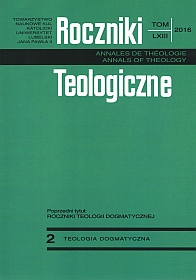The Beginning and an Outline of the Dogma of the Trinity
Abstract
The present article outlines the beginnings of the dogma of one God in three Persons. Albeit its germ was already present in Jesus' teaching, its growth happened in conditions that were sometimes adverse. This is also testified to by the fact that the very notion and word “Trinity” (Trinitas) – as one more precise and distinguished from “Triad” (Triás) that was a little older – appeared only at the end of the 2nd century. This development resulted from the Christians' absolute necessity, for they had to find a plane, on which faith in Jesus Christ as God's Son is in accordance with the truth that there is one God. The early twilight, or even disappearance of the Jewish Christianity current that was more sensitive to confessing a strict – that is numerical, and not only qualitative – unity of God, was marked by an influence of Greek philosophy. Its popular form was Middle Platonism combined with Stoicism that was mainly characterized by the teaching about the Word (ho Lógos), that is a divine intermediate being between God and the world that, by the way, was supposed to be created by Him. Its way to the Biblical theology was cleared by an Alexandrian Jew whose name was Philo, a Jesus's peer, and this way influenced the Christian thought as soon as the middle of the 2nd century thanks to Justin, and then – to Origen and the Cappadocian Fathers. Even today it is a feature of history of Eastern theology, where the verdict of the First Council of Nicaea is an exception; and the verdict is not without a connection with the thought of Tertullian who worked in the Latin Carthage at the turn of the II and III centuries.
References
Altaner B., Stuiber A., Patrologia ( z j. niem. tł. P. Pachciarek), Warszawa 1990.
Beatrice P. F., Introduzione ai Padri della Chiesa, Vicenza 1982.
Chadwick H., Kościół w epoce wczesnego chrześcijaństwa (z j. ang. tł. A. Wypustek), Warszawa 2004.
Dünzl F., Breve storia del dogma trinitario nella Chiesa antica (z j. niem. tł. C. Danna), Brescia 2007.
Huculak B.J., OFM, Jana Dunsa Szkota nauka o Osobie w Trójcy, „Roczniki Teologii Dogmatycznej” 3(58)2011, s. 113-140.
Huculak B.J., OFM, Wczesnochrześcijańska nauka o Duchu Świętym w przekazie Dydyma Aleksandryjskiego, nazywanego Ślepcem, „Roczniki Teologiczne” 50(2003), z. 2, s. 101-116.
Huculak B.J., OFM, Herbem Trójca i Wcielenie. Wybór pism pomniejszych, Rzeszów 2014.
Huculak B.J., OFM, Najświętsza Trójca na tle dzieła zbawczego, Kalwaria Zebrzydowska 2000.
Huculak B.J., OFM, W sprawie odniesienia poglądu Focjusza do Symbolu Nicejsko-Konstantynopolitańskiego, „Analecta Cracoviensia” 25(1993), s. 147-154.
Kelly J.N., Początki doktryny chrześcijańskiej (z j. ang. tł. J. Mrukówna), Warszawa 1988.
Montanelli I., Storia dei Greci, Mediolan 2004.
Mossé C., Pericle, l'inventore della democrazia (z j. fr. tł. B. Gregori), Rzym−Bari 2006.
Nowowiejski A.J., Msza święta I, Warszawa 2001.
Pierrard P., Historia Kościoła katolickiego (z j. fr. tł. T. Szafrański), Warszawa 1984.
Prestige G.L., Dio nel pensiero dei Padri ( z j. ang. tł. A. Comba), Bolonia 1969.
Rauschen G., Patrologie, Fryburg Br. 1926.
Simonetti M., La crisi ariana nel IV secolo, Rzym 1975.
Copyright (c) 2016 Roczniki Teologiczne

This work is licensed under a Creative Commons Attribution-NonCommercial-NoDerivatives 4.0 International License.





